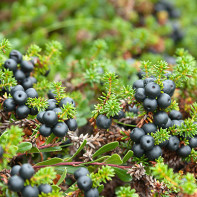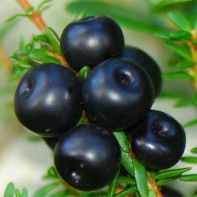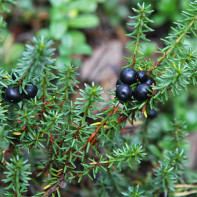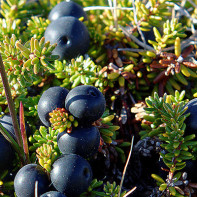Shiksha: medicinal properties and contraindications
Dwarf but very attractive shrub Siberian shiksha is widely used in folk medicine. This plant is known under different names - waterberry, marshberry, verez berry, crowberry. Its properties have not yet been fully studied by official medicine. However, it is considered a promising anti-diabetic remedy. Its sedative and anticonvulsant effects are noted, as well as a number of other properties, which will be discussed below.
Chemical Composition
Both the leaves and berries of shiksha have useful properties. However, the chemical composition of them will be different. First of all, it should be noted that shiksha berries contain ascorbic acid in very large amounts - in the range of 70-90 mg per 100 g of weight. According to this indicator, watermelon is somewhat inferior to prunus and rosehips, but it is still considered a fairly high level. It is due to this content of vitamin C that the berries of this plant have become one of the most effective remedies for scurvy in the northern regions. In addition, ascorbic acid has antioxidant properties and has a beneficial effect on the condition of blood vessels and the circulatory system in general.

Thus, berries contain:
- Quercetin, which as well as other flavonoids, has antioxidant and anti-inflammatory properties.
- Rutin - the importance of this substance is difficult to overestimate. It reduces platelet aggregation and prevents the formation of blood clots, so in the long term, watermelon can be used to treat strokes and heart attacks. Rutin also improves vascular health and has anti-inflammatory activity. A number of studies show that it normalizes iodine uptake by the thyroid gland, but so far this aspect has not been adequately studied.
- Anthocyanins are the pigments that give the fruit a darker color. At the same time, they have anti-inflammatory effects, and also improve the barrier function of the intestine and generally normalize lipid metabolism.
- Fatty oils necessary for normal metabolism.
- Coumarins. They are represented mainly by ellagolic acid, which has cardioprotective properties, which makes aqua useful for cardiovascular diseases. It also has anti-inflammatory and reparative properties, that is, it promotes tissue repair.
- Ursolic acid, which is considered an important component of anti-diabetic drugs and helps to fight overweight.
- Tannins and wax.
The fruit also contains various types of fruit sugars and essential oils, though not in large enough quantities to give them a distinct taste.
The leaves and branches contain coumarins, alkaloids, essential oils, and vitamin C, although in smaller amounts. In addition, the above-ground part of Siberian shiksha contains the above mentioned quercetin and rutin with their unique properties, and tannins, which have astringent properties and make the plant an effective remedy for diarrhea. The leaves and branches of the plant contain caffeic acid. It has anti-inflammatory and immunomodulatory effects, and some studies have shown that it can stop the development of malignant tumors (but this aspect has not yet been studied enough). Of the trace elements contained in the leaves, manganese is also worth mentioning.
How it looks and where it grows
Sagebrush is a small creeping shrub. Today there are various garden varieties (some even reach 50 cm), but in natural conditions its height is on average 20-25 cm. It is an evergreen plant with long shoots that can reach 100 cm in length.
In nature, it grows in clumps, which from a distance resemble patches on the ground. It is a strongly branching shrub, so each clump is actually a single specimen of the plant. The crown shape of this shrub is pillow-shaped. The stem has a dark shade, it is densely covered with small leaves - each leaf plate up to 10 mm long has the edge wrapped up. They are so small and narrow and grow so densely that they look like needles. From a distance, the plant looks like a dwarf herringbone. Interestingly, each leaf lasts on the shrub for up to five years.
At the same time, the leaves of the waterberry are dark green on the front side, but seem reddish on the back side, as they have dense pubescence of the corresponding shade. By the way, the stem of young plants is also covered with brownish fluff.
As noted above, the shrub branches strongly, and some of its branches gradually form adventitious roots. Over time, the plant occupies more and more space, but in the center of the cluster, the branches begin to die off.
This plant blooms with small and not very pretty flowers with three petals. They can have a pink, red or purple hue. In the middle belt of Russia, flowering usually begins in April-May, but in Siberia - only in May-June. They are pollinated not only by bees but also by flies and butterflies.
And in August-September, round black berries with a bluish patina appear on the bushes. Their juice also has a dark, most often purple tint, all due to the presence of the above mentioned anthocyanins. However, these hard-skinned berries have almost no flavor and appear watery. The berries appear on the shrub as early as fall, but if not picked, they will last on the branches until spring.
In the wild in Russia, waterberry is found mainly in Siberia and the Far East. There this plant prefers damp places, swampy terrain, peat bogs. Very often it grows in rock crevices. That is, the shiksha is well tolerated even by harsh natural conditions, which makes its purposeful cultivation quite promising.
Species
Currently in botany, there is no consensus on the classification of the Siberian shiksha. A number of scientists believe that the genus Vodanika is monotypic, and there is only one species in it - black waterberry (aka blackberry). But it is considered that in nature it is divided into Japanese and Asiatic shiksha, and the former is practically never met on the territory of Russia. But there is another opinion that the genus Vodyanika unites three species at once. These are black, oboe and red. In any case, only one species is cultivated for medicinal purposes - black-flowered waterberry, which was described in general terms above.
In landscape design, shiksha is used in rockeries and on alpine slides. Breeders have bred several varieties of it, for example:
- Citronella - a plant with foliage of a unique lemon hue.
- Smaragd - a shrub with dark green leaves.
- Bernstein - a variety with very pale yellow leaves.
Also popular are such varieties as Lucia and Ireland. But all the differences between them are reduced mainly to the decorative appearance, but the chemical composition of the above-ground part will be about the same.
Harvesting and storage
The shiksha grass is collected during the flowering period of the plant, the fruit - after ripening. The twigs are cut off with a sharp knife, then sorted so that there is no spoiled, and spread out on a cloth under awning or in a room with good ventilation.
Sometimes only the shiksha leaves are picked separately, although this is a more time-consuming process. This is also done at the beginning of flowering of the plant. The leaves can be plucked by hand, you do not have to take a knife for this. But some herbalists use small scissors for this. As a medicinal raw material is better to take not the top, and the lower and middle leaves, and damaged or wilted specimens for these purposes are not suitable. Then everything is sorted out again, remove the damaged grass and lumps of earth, and dry it as with other medicinal raw materials. Periodically, when drying the grass and leaves vodanika turn in order to process went evenly.
It is believed that the next harvest of crowberry from the same area can be made only after 8 years, so it makes little sense to grow the plant in the garden only for its medicinal properties.
Watermelon berries are harvested in the morning or in the evening. It is believed that those that are collected in the daytime, then deteriorate quickly. Berries can be dried naturally or you can use a fruit dryer, but only put it in a gentle mode of operation with a temperature of up to 40 degrees, so as not to destroy those useful substances that are contained in the fruit.
Dried raw materials are stored in cloth sacks or paper bags in a dry place so they do not dry out and do not spoil. Shelf life - 2 years.
There are other ways to process the fruit. For example, they can be frozen - then the berries are sorted, discard spoiled, but in general the finished raw material is not washed, but simply poured into plastic boxes for foodstuffs and put in the freezer. During the year they can be used to make teas and decoctions.
Some herbalists recommend preparing for the winter juice from the berries of crowberry. To do this, using a juicer juice is squeezed from berries and bring it to a boil, and then immediately turn off so as not to destroy its vitamins. This juice is rolled in pre-sterilized glass jars. It can be drunk little by little to relieve swelling, reducing excess weight, it can also be immunomodulatory agent.
Therapeutic properties of shiksha
Official medicine has not sufficiently studied the properties of cowberry. However, scientists continue research, because the multicomponent complex of biologically active substances may be useful in the future. It is already known that the aqueous extract (in the form of infusion or decoction) of shiksha leaves and grass has anticonvulsant and even antihypoxic properties.
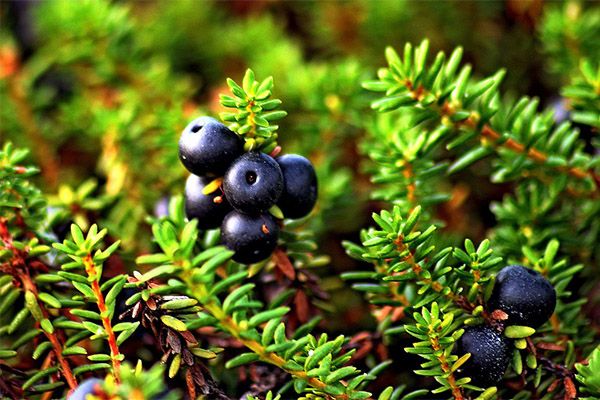
A number of studies have proved cerebro-protective effect, that is, the plant protects the cells of the central nervous system, which allows to use it in the treatment of some destructive pathologies. Thus, the effectiveness of preparations of vodonika in epilepsy has been proven. They can also be used in the treatment of serious diseases such as multiple sclerosis, tick-borne encephalitis and even paralysis of various etiologies.
The studies conducted by Tomsk scientists used an aqueous extract of the grass, leaves, and berries of crowberry. It was used to treat patients with epilepsy as well as people with post-stroke paralysis. Such a remedy actually reduced the number of epileptic seizures and alleviated their severity. In patients with paralysis, regular intake of waterberry extract contributed to an increase in the volume of movements, which can already be considered an excellent result.
Cerebro-protective properties make this plant a promising remedy for memory and cognitive dysfunction, for migraines and headaches. Already today it is used in dietary supplements, which should help with rapid fatigue and loss of tone.
Shiksha also has a sedative effect, so it is taken as a sedative and for sleep disorders. Its choleretic and diuretic properties have been proven, allowing the plant to be used in diseases of the kidneys and hepatobiliary system. In addition, it has a hypotensive effect, which makes it possible to take drugs on its basis to reduce blood pressure.
Watermelon in folk medicine
In folk medicine, the black watermelon has found a wider application. On its basis make decoctions and infusions, which are used:
- For headaches of various origins;
- Physical and psycho-emotional fatigue;
- chronic fatigue;
- insomnia;
- Edema of different nature;
- Gastritis with hyperacidity;
- Colitis and some other intestinal diseases of inflammatory nature;
- Difficulty in urination;
- As a sedative, speeding up the metabolism, the prevention of infectious diseases.
The high content of vitamins and minerals made watermelon an effective remedy against scurvy in the old days, which was especially important in the northern regions.
In Tibetan medicine, watermelon was used both as an internal and external remedy. In the first case, it was the treatment of liver and kidney diseases (and modern science has confirmed these properties of the plant). In the second case, shiksha-based remedies were used to treat acne, various skin irritations, rashes, which is also not unreasonable, since watermelon contains many anti-inflammatory substances.
As for specific recipes for use, there are many variations, as folk medicine has accumulated many ways over the years.
For example, for migraine relief, you can choose one of three options:
- Take 2 tablespoons of dried leaves of crowberry, pour 500 ml of cold water, bring to a boil, boil for 5 minutes. Then the resulting remedy insist 40-60 minutes, pass through a folded gauze in several layers, and take 3-4 tablespoons 5 times a day.
- Decoction is prepared a little differently. Take 2 tablespoons of crushed dried material (berries, leaves, twigs mixed in equal proportions), pour 500 ml of boiling water and heated in a water bath for 10 minutes, but do not bring to a boil. Accepted in the same proportions as those mentioned in the first recipe.
- Take 20-30 drops of an alcoholic tincture of shiksha in 50 ml of water and take three times a day for half an hour before meals. This remedy is also considered an effective remedy against vegetovascular dystonia.
Watermelon will be useful for other diseases:
- With various vascular pathologies of the organs of vision (cataract, glaucoma, increased intraocular pressure), the so-called napar is used. It is prepared as follows - take 1 tablespoon of dried crushed raw material (twigs and leaves) and pour 2 tablespoons of boiling water. That is, the herb is steamed, becomes moist and releases into the water all the useful substances. This wet raw material is cooled, and then very carefully squeezed through gauze - the resulting liquid is injected into the eyes 5-6 times a day. 1-2 drops in the lower eyelid is enough. At the same time, herbalists recommend supplementing the treatment by taking decoction of shiksha (1 tablespoon 3 times a day) or tincture (30 drops per 50 ml of water). The course of treatment is 90 days, then a break is taken for at least a month.
- In dry eye syndrome. This disease is not associated with vascular abnormalities, it is caused by prolonged work at the computer, and in women during the menopause - by hormonal changes. In this case, do not pair, but a very strong infusion - 2 tablespoons of dried plant material in 100 ml of boiling water. This product is infused for an hour, then very carefully filtered, you can even use a strainer. Put 2 drops in each eye every 2-3 hours. The remedy is also used for a course of at least one month, then take a break.
- In the treatment of withdrawal syndrome. In this case, we are talking not only about alcoholism, but also about drug addiction. But the remedy is prepared according to the same recipe, because it helps to remove from the body the toxins that are the cause of this syndrome. Take 1 liter of high quality whey, add 4 tablespoons of the herb shiksha, bring it to a boil and leave it for 8 hours (best in a thermos, or you can wrap the container with a warm cloth). Strain it is not necessary, use it in this form, 1 cup 4-5 times a day.
- With chronic fatigue and psycho-emotional fatigue. In this case you can also use it in different ways. The simplest variant is the use of a ready-made alcoholic tincture of vodanika - 20-30 drops per half-cup of cold water (take three times a day, half an hour before breakfast, lunch and dinner). The second option - the classic decoction of waterberry (its recipe will be presented below) is added to the bath, which is taken before bedtime. It should be prepared in a volume of 1-2 liters, using the presented proportion. The decoction should be strong enough, of a dark green color. The bath can be taken at least every day, the effect will be noticeable at once. Finally, you can drink the tea of waterberry or the juice described above.
- For various inflammatory diseases of the kidneys. For this purpose, a decoction is prepared, which allows you to get rid of edema caused by excessive fluid retention in the body. To do this, take 3 tablespoons of dried leaves for 1 liter of boiling water, bring to a boil, leave on low heat, allow to cool and filter. This remedy, however, with caution should be taken in the presence of kidney stones, as well as in renal failure.
- When epilepsy take 100 grams of dried berries cowberry, pour 0.5 liters of boiling water and insist for an hour in a thermos (or just wrap the container with a warm cloth). The dosage of funds for children and adults will be different. Children from 7 years of age can use 1 tbsp. spoon per day, and adults - 7 tbsp. spoons per day. There is another version of the broth, when the same amount of berries pour 1 liter of boiling water and heated in a water bath for half an hour. This remedy can be drunk as a preventive measure. The duration of treatment is at least 1 month. Repeat it no more than once a quarter.
- For the treatment and prevention of infectious and colds. Take 2 tbsp dry material (and use the entire aboveground part, including fruit and flowers), pour 0.5 liters of boiling water and infused in a thermos overnight. The remedy is drunk 150 ml three times daily before meals. At the same time it is recommended to take ½ tsp. spoonfuls of perga (bee product containing many vitamins and minerals, which allows to compensate possible excessive diuretic effect). The course of treatment is at least 40 days. This remedy is recommended to drink when recovering from a serious illness and even with a concussion.
In folk medicine, on the basis of shiksha berries and leaves make healing baths, which help with cramps and vasospasms. There are two ways:
- Take about 300-400 grams of berries and leaves of crowberry, pour into a cloth bag and drop it into a bathtub filled with hot water.
- Take 1 liter of raw materials (leaves, twigs, berries) for 5 liters of boiling water - such a volume of insistence in a bowl, which is covered with the top of the second basin and wrapped with a plaid. Under such conditions, the liquid infused for 8-12 hours, after which the infusion is filtered through gauze (portions) and poured into a bathtub with hot water.
Take a therapeutic bath can be for 20-30 minutes, no longer. The recommended course of treatment is 10 procedures, one per day. It can be repeated in six months.
Types of medicinal compositions
The most popular form of application of this remedy is an infusion of dried herbs. It is prepared as follows - take 2 tablespoons per 0.5 l of boiling water, insist for an hour, then strain. Such a remedy is used, for example, for epilepsy, various CNS diseases, etc. But there are also other options.
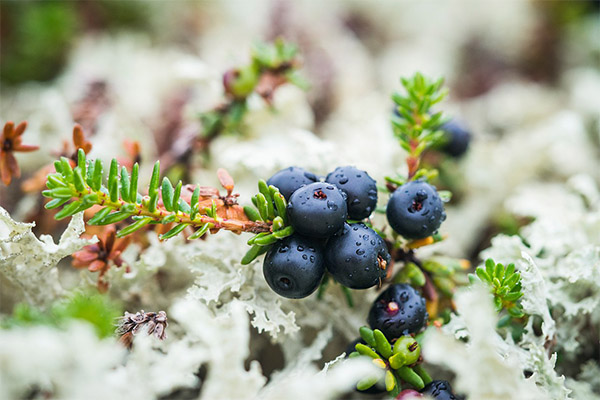
Tincture .
Tincture of any medicinal plant is made on the basis of alcohol. In this case, it can be ethyl alcohol, which is sold in pharmacies, vodka or wine.
The first option is a solution of alcohol (40-50%) or high-quality vodka. They take a glass container, pour into it 5 tablespoons of dry crushed raw materials and pour 1 liter of vodka or alcohol solution. Insist the product for 10-12 days. Keep the container in a dry place so it does not get sunlight, shaking it every day. After this period, the remedy is strained and poured into a convenient container for use. It is believed that it has maximum effectiveness against epilepsy, because the alcohol extract is more concentrated than water. It is taken by 1 tsp. three times a day, diluted with a small amount of water.
The second option is a tincture based on dry red wine. In this case, take 5-6 tablespoons of dry herbal raw materials for 1 liter of wine. The technology of manufacture is the same - the container is kept 10-12 days in a dry and dark place, shaking occasionally. The finished product is filtered. In this case, such a tincture can be used without diluting with water - 30 ml (in fact - it is a shot) three times a day, regardless of meals.
Decoction
Decoction of dropsy can be prepared in different ways. In some recipes, only the leaves and grass are used for this - take 2 tbsp. spoonfuls of such raw materials for 2 cups of boiling water, bring to a boil again, leave on low heat for 5-7 minutes, then cool and strain.
But some herbalists consider a more effective option combined decoction, for the preparation of which in equal parts take the above-ground part (grass and leaves) and fruits of cowberry. For example, 10 g of each type of raw material is poured a glass of boiling water, cover the container with a lid and put on a water bath for at least 15 minutes, then cooled and filtered. Decoctions of this type are considered an effective anticonvulsant. Some herbalists also use them to treat withdrawal syndrome in alcoholism.
Tea .
To do this, take 3 tbsp. of crushed dried herbs of crowberry and pour 1 liter of cold water. This remedy is brought to a boil, infused for 10 minutes, and then filtered. The drink can be drunk as an ordinary tea - for example, 1 glass in the afternoon to relieve fatigue. At night it is better not to drink it, because it has diuretic properties. With kidney disease, it is also recommended to drink 1 glass of the remedy a day - but only in the morning. To improve the taste, you can add a little honey to the drink.
Cosmetic applications
Mistletoe Siberica is used as a raw material for various finished cosmetic products - shampoos, balms, lotions and even face creams.
But this plant can be used in home cosmetology. For example, it is used to make an infusion that can be used in the treatment of seborrhea. Prepare this medication as follows - 4 tablespoons of dried plant material pour 0.5 liters of boiling water, then insist for an hour and pass it through twice folded gauze before use. This product is rubbed into the scalp after washing - so it will be most effective against dandruff. It is also used for rinsing - just for preventive purposes, so that the hair is thick and shiny.
Siberian shiksha is also useful for the skin. Not without reason, some cosmetic brands add an extract of waterberry to the composition of day creams for the face. Especially useful are watermelon berries, as they contain many antioxidants that slow down the aging process. Therefore, the above described juice from shiksha berries can be added to any facial masks (5-7 ml per 50 ml of the main mass).
You can also freeze cosmetic ice with the juice of waterberry and wipe the skin with it. It is best to do this twice a day: in the morning - so that the skin "wakes up", and in the evening, to get rid of the effects of contact with all the harmful substances contained in the air of the big city.
Decoction made from the leaves of waterberry will help with acne. Take 1 tbsp. spoonful of herbal raw materials for 300 ml of boiling water, heated for 15 minutes in a water bath, cooled to an acceptable temperature and filtered. The product is used as a lotion to cleanse the skin with a normal cleanser.
Contraindications for use
In principle, vodnica has almost no contraindications. The exception is the cases of individual sensitivity and the presence of an allergic reaction to the components that it contains. In addition, remedies on the basis of the plant are not recommended during pregnancy, although they help to relieve swelling, delivering so many problems to future mothers. The fact is that the effect of waterberry on the fetus has not yet been studied. During lactation, it is not taken because it can cause an allergic reaction in the child. Children under 5 years of age should also not be given it - however, this applies to other phytotherapeutic agents, too, especially if the child has already had cases of atopic dermatitis.
With caution, you should use preparations based on dropsy people with low blood pressure, as infusions and decoctions can aggravate the situation.
Interesting facts
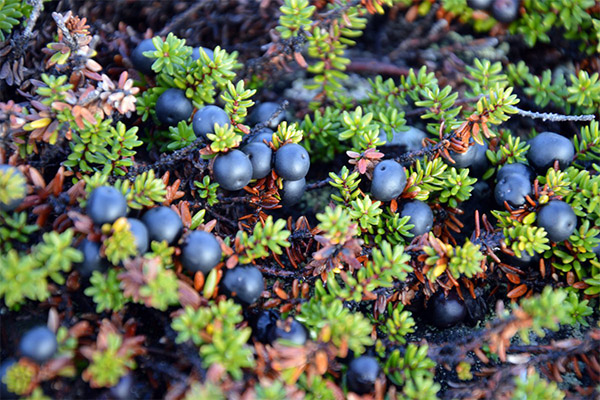
Shiksha in northern peoples is an important part of the diet. Research confirms that shiksha was used as a remedy for various diseases by the Inuit and the Saami, the indigenous population of the tundra, where this berry grows. In those times, berries were prepared for the winter, but not just dried, and mixed with fat and consumed as food to prevent scurvy. Of course, in those days they did not use butter and especially sunflower oil in those regions, and berries were mixed with seal fat. Russian speaking peoples of the North had a separate name for this dish - "kirilka" which is even mentioned in the Dahl dictionary, although some sources mention "tolkusha" which is a mixture of berries with fish and fat.
Also in the culinary tradition of these peoples vodanika is used in fresh and soaked form. It does quench one's thirst well, though one would not call it tasty. But judging by the fact that in some regions it is called in the olden days "dear grass," it was still valued for its effectiveness, not for its culinary qualities. In addition to serving as a medicine, the berries were also used to make a natural dye for wool - the juice of these fruits gave the fabric a beautiful cherry hue.
By the way, in modern conditions it is used to make jam, various sweets, including marmalade, sauces for meat and fish dishes and even alcoholic beverages. It is recommended to consume its berries with fermented dairy products to better absorb calcium.
Watermelon berries are also popular in the Far East. This is especially true of Tibetan medicine, in which this plant was considered an effective cure for anthrax. However, these berries and leaves were mainly popular only in two branches of the Tibetan tradition - Mongolian and Buryat, which developed independently of each other. And already in those days, long before the chemical composition of the "dear herb" was investigated, the healers of Tibet knew that it was good for the liver.
«Important: All information on this site is provided for informational purposes only. information on this site is provided for informational purposes only. Please consult with a health care professional before using any of our recommendations. health care professional before applying any of the recommendations. Neither the editors nor the authors shall be liable for any possible harm caused by materials."


